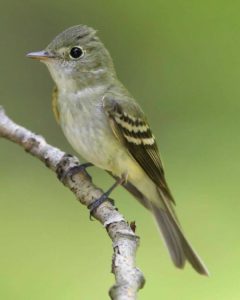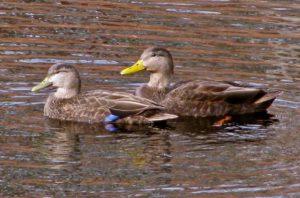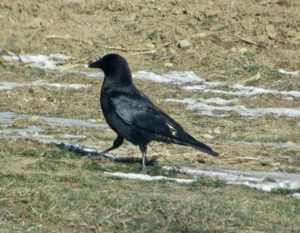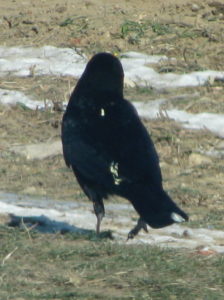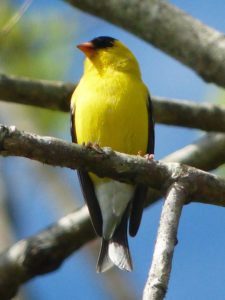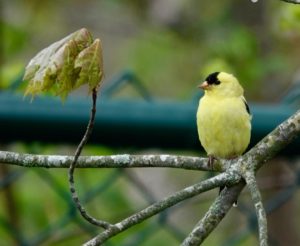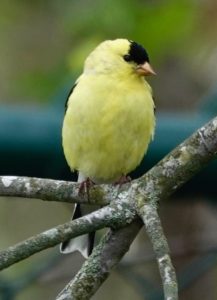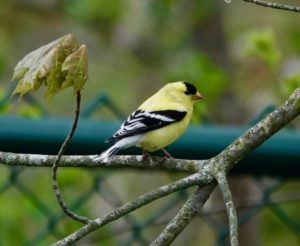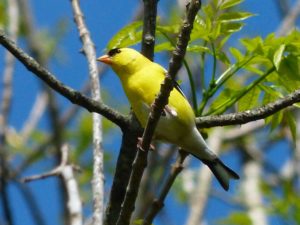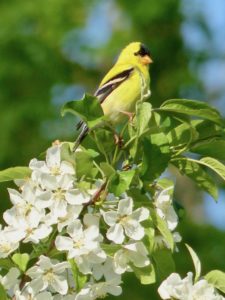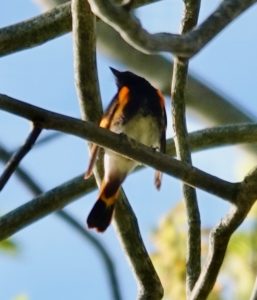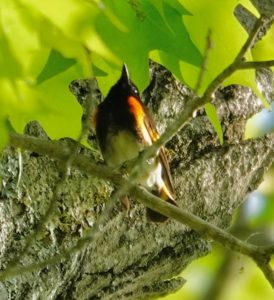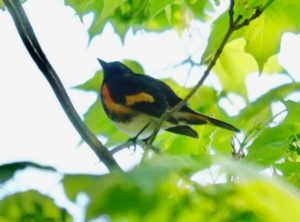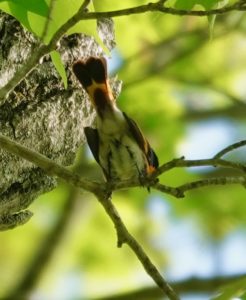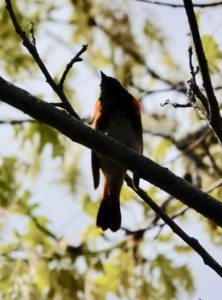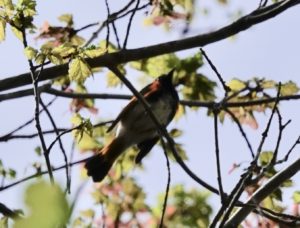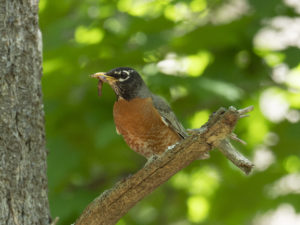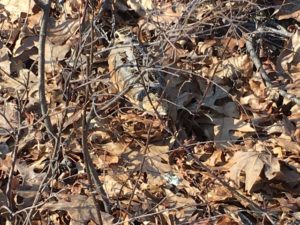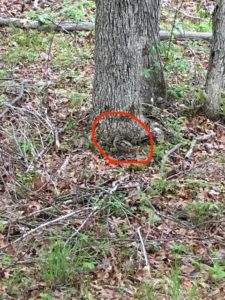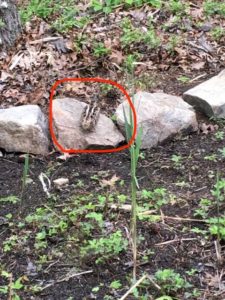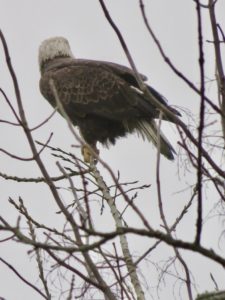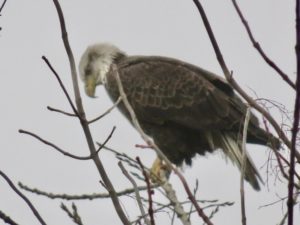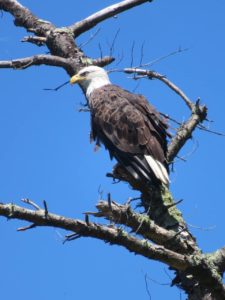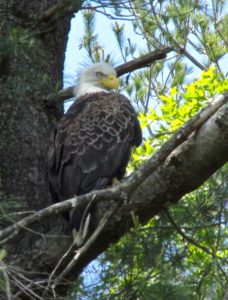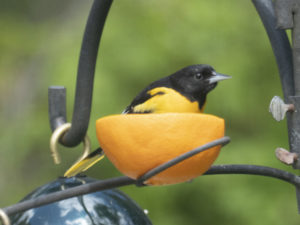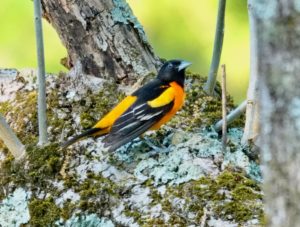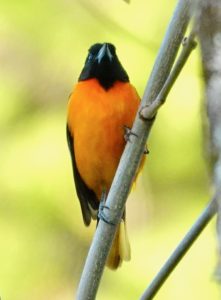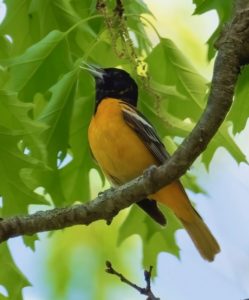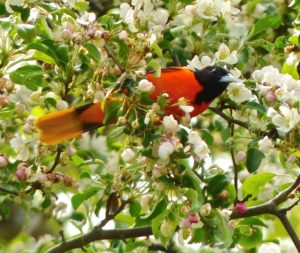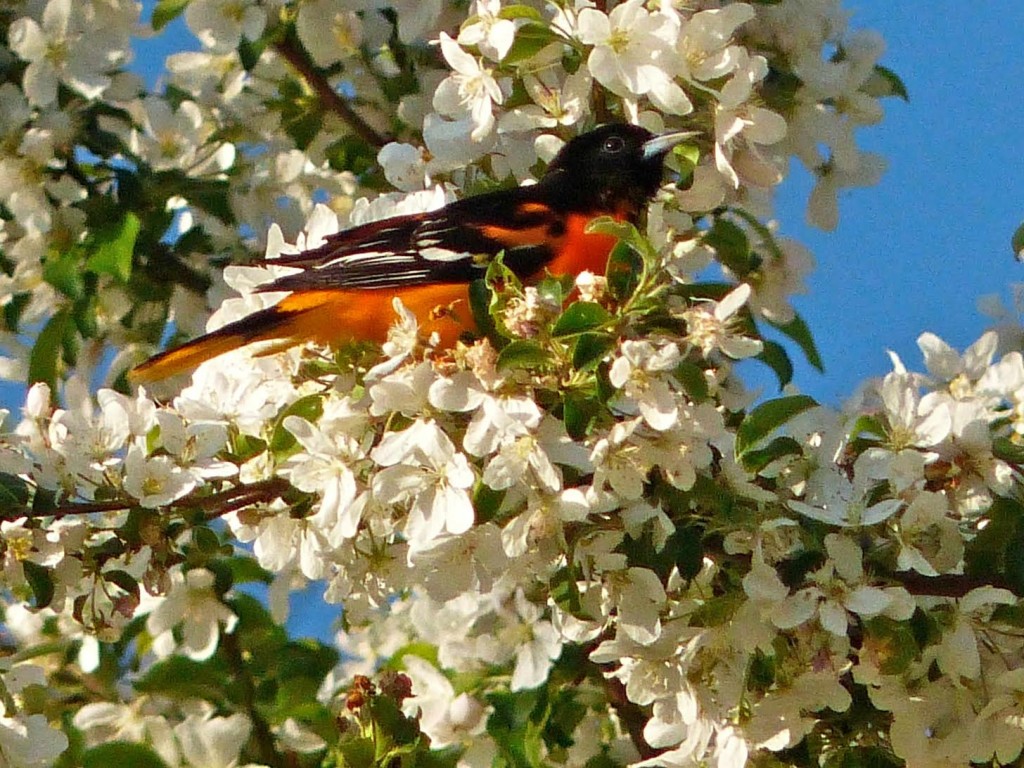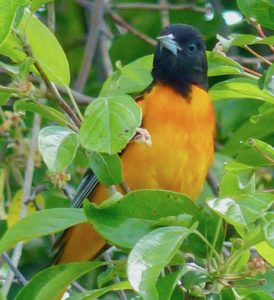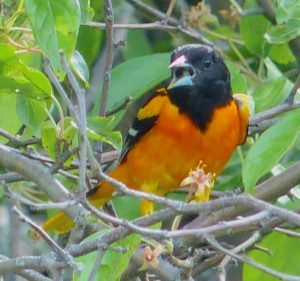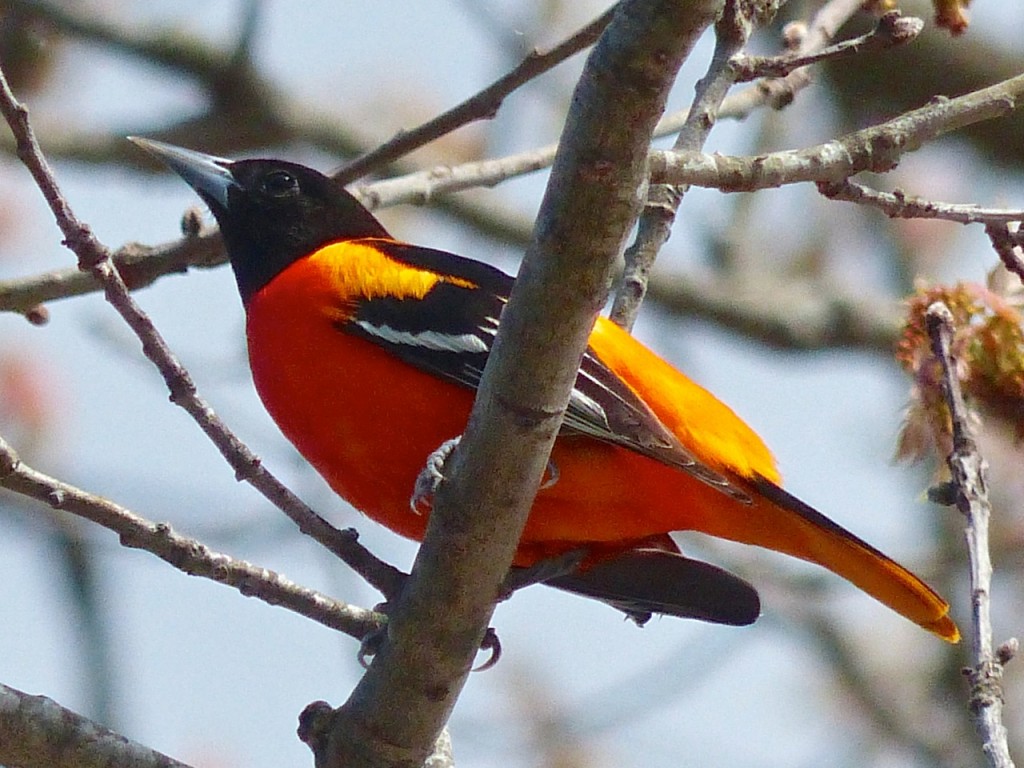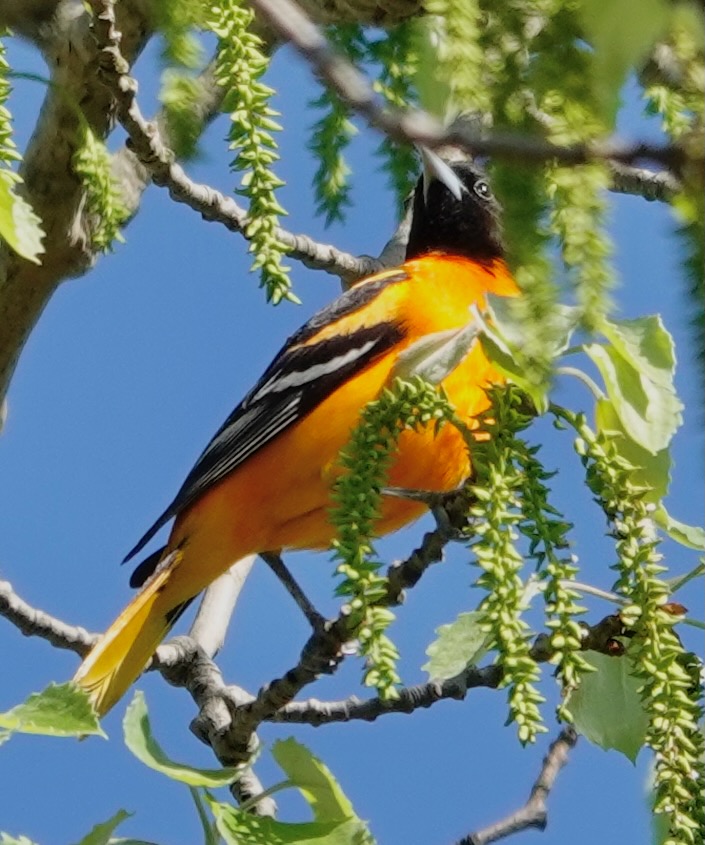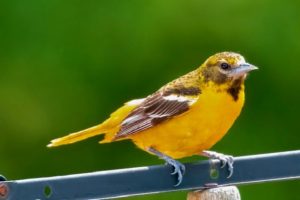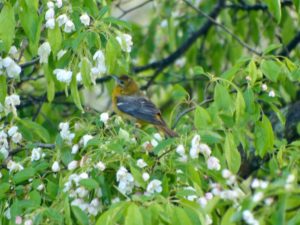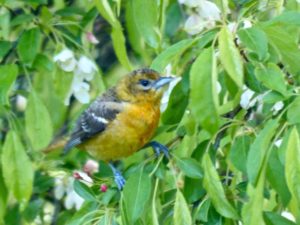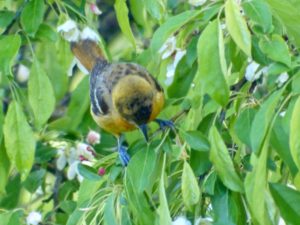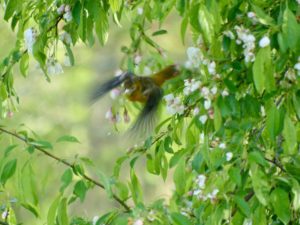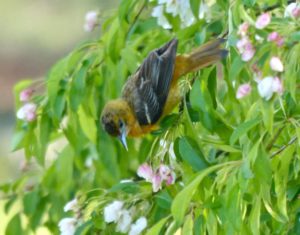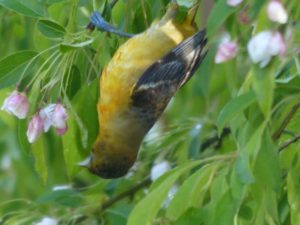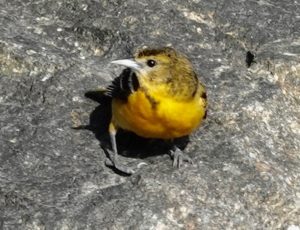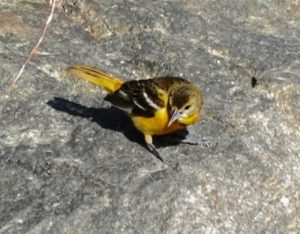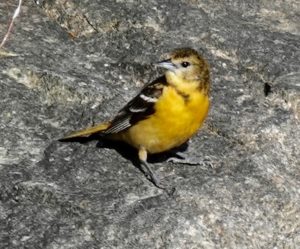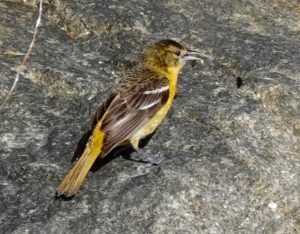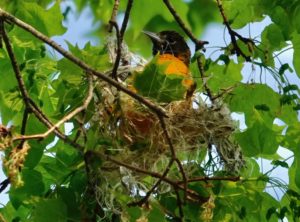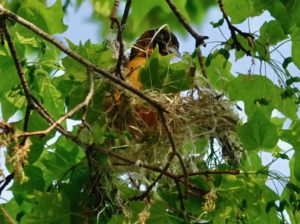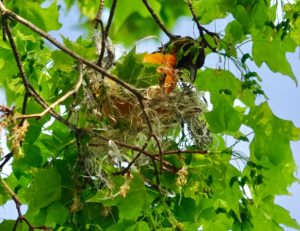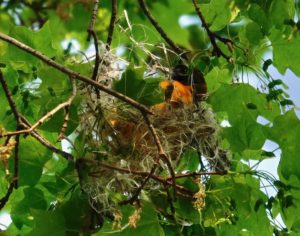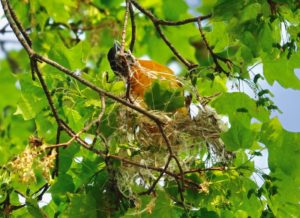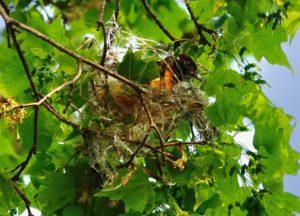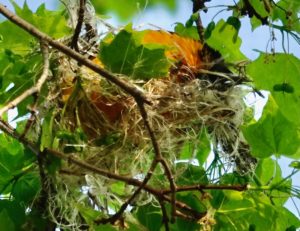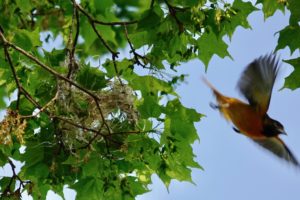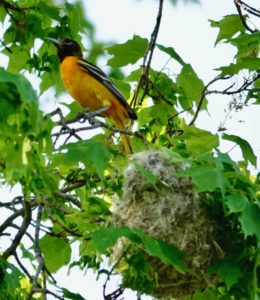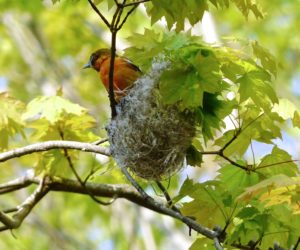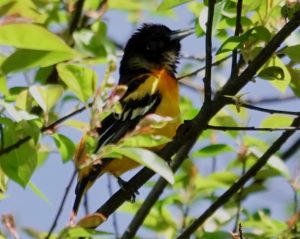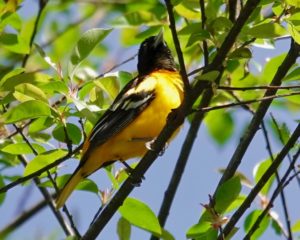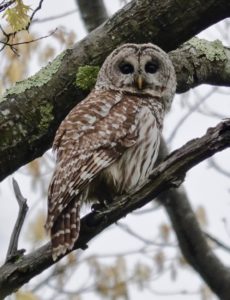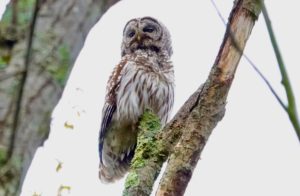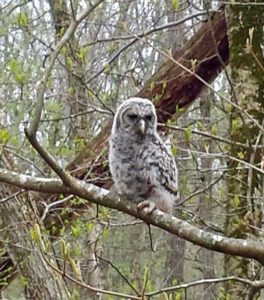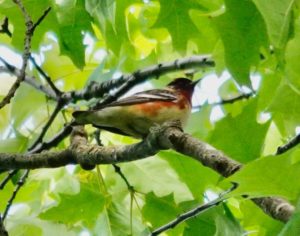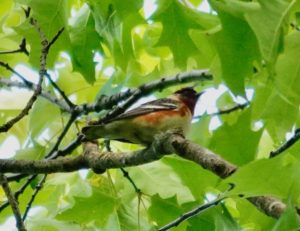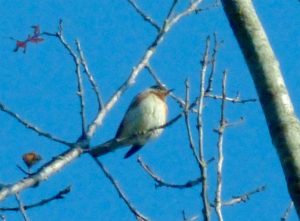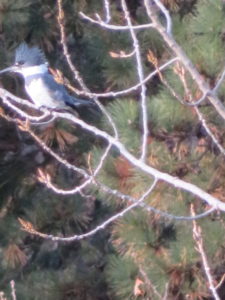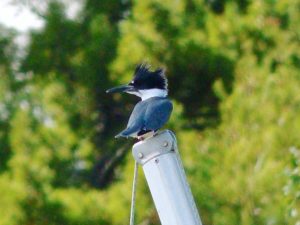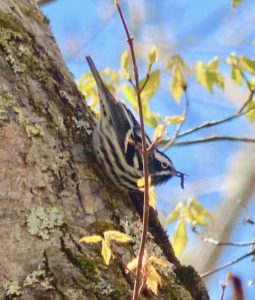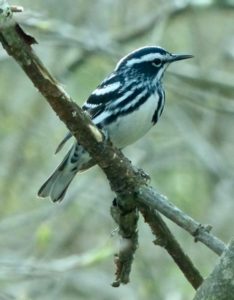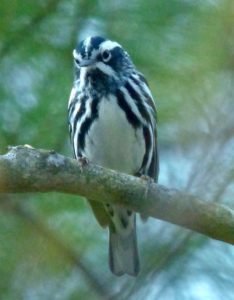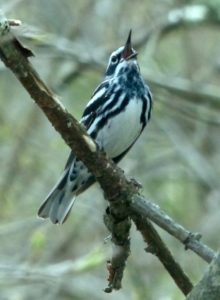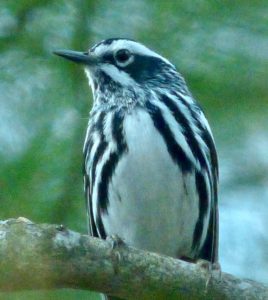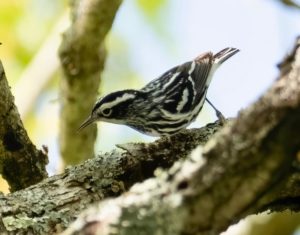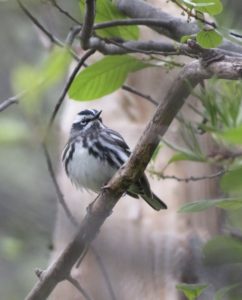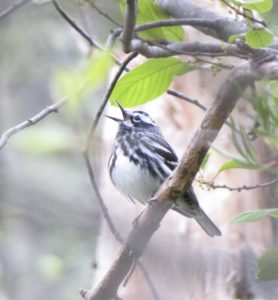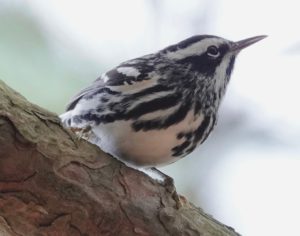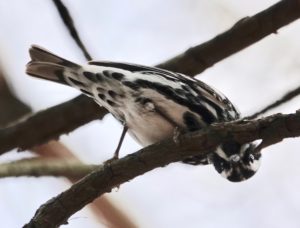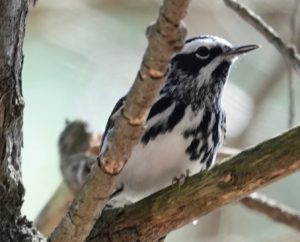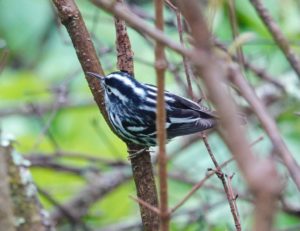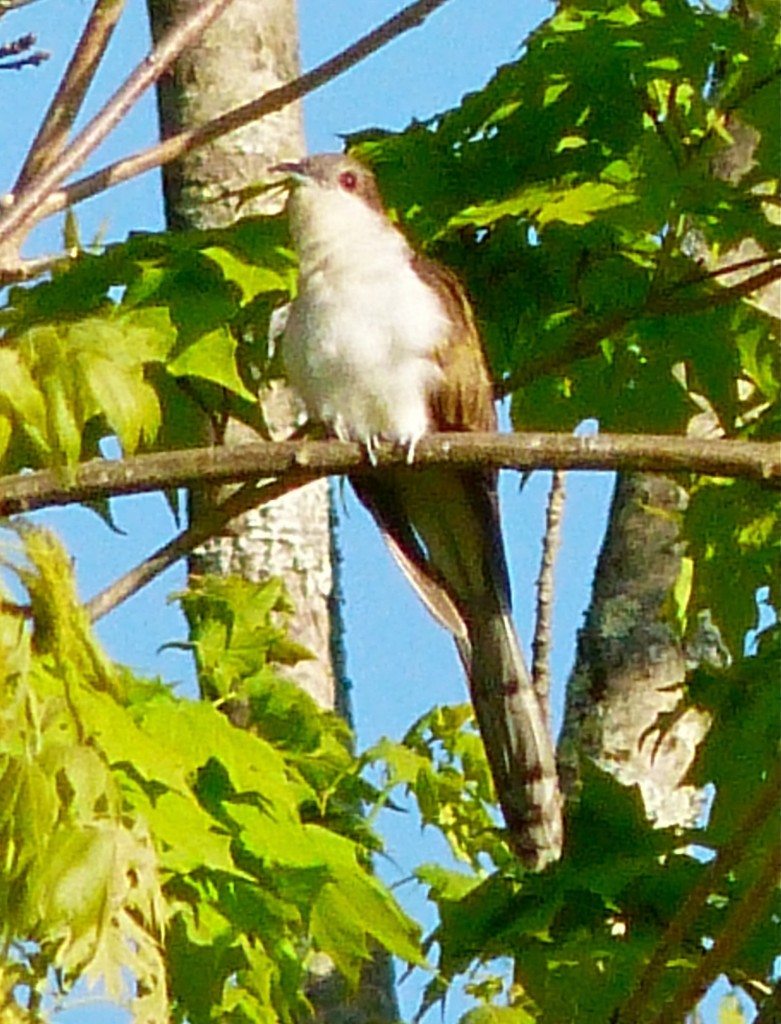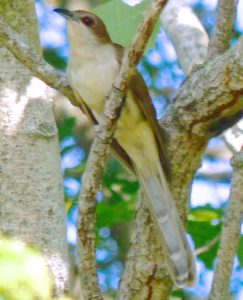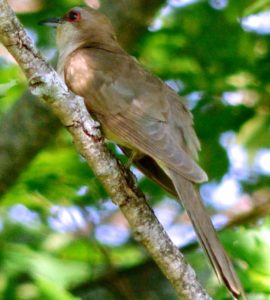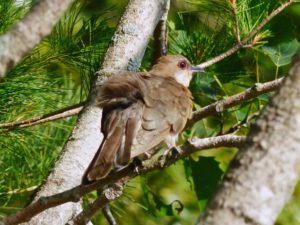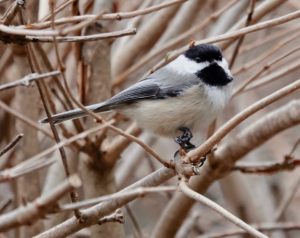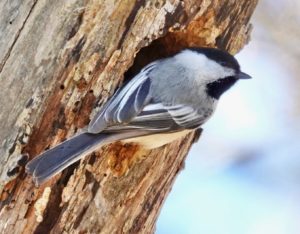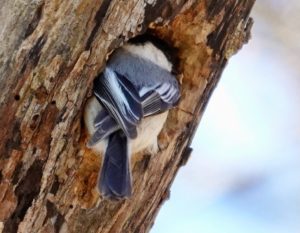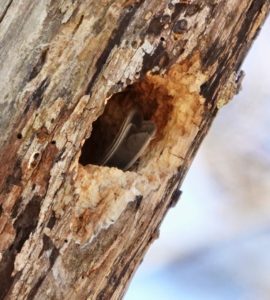Sightings – Birds
Observer: Barry Dulong
Observation Date: 6/2/24
Observation Time: 10:30 a.m.
Observation Location: Moose Hill Audubon Wildlife Sanctuary
Common Name: Acadian flycatcher
Scientific Name: Empidonax virescens
Comments: Picked up call on Merlin. Easy to spot chasing flying insects.
More Information: All About Birds
(The attached photo comes from the internet)
Observer: Paul Lauenstein
Observation Date: 12/17/11
Observation Time: 11:40 a.m.
Observation Location: Sawmill Pond
Common Name: American Black Duck
Scientific Name: Anas rubripes
Comments: This pair of black ducks mingled with some Canada geese and mallards. Shooting photos of this pair reminded me of my grandfather, who lived on Cape Cod and used to shoot black ducks for food during the first half of the twentieth century before I was born.
More Information: Avian Web
Observer: Paul Lauenstein
Observation Date: 12/12/09
Observation Time: 11:40 a.m.
Observation Location: Wolomolopoag Street (Ward’s Barry Farm)
Common Name: American Crow (mutant)
Scientific Name: Corvus brachyrhynchos
Comments: This mutant crow has a few white feathers mingled among the normally black feathers.
More Information: All About Birds: White Crow
Observer: Paul Lauenstein
Observation Date: 5/13/15
Observation Time: 9:35 a.m.
Observation Location: Moose Hill Audubon Wildlife Sanctuary
Common Name: American Goldfinch
Scientific Name: Spinus tristis
Comments: One of Sharon’s most striking – and most common – songbirds. Goldfinches are frequent visitors to bird feeders.
More Information: Audubon Guide to N. American Birds
Observer: Paul Lauenstein
Observation Date: 5/15/20
Observation Time: 9:35 a.m.
Observation Location: Flume house near the Lake Massapoag boat ramp
Common Name: American Goldfinch (male)
Scientific Name: Carduelis tristis
Comments: This common finch travels in groups. Its song sounds like “per-chick-o-ree, per-chick-o-ree” interspersed with an occasional mewing sound.
More Information: All About Birds
Observer: Paul Lauenstein
Observation Date: 5/23/16
Observation Time: 8:50 a.m.
Observation Location: Moose Hill Audubon Wildlife Sanctuary
Common Name: American Goldfinch
Scientific Name: Carduelis tristis
Comments: This common finch travels in groups. Its song sounds like “per-chick-o-ree, per-chick-o-ree” interspersed with an occasional mewing sound.
More Information: All About Birds
Observer: Josh Simons
Observation Date: 6/25/11
Observation Time: 1:00 p.m.
Observation Location: Moose Hill area
Common Name: American Goldfinch
Scientific Name: Carduelis tristis
Comments: The first photo is of a female; the second a male.
More Information: All About Birds

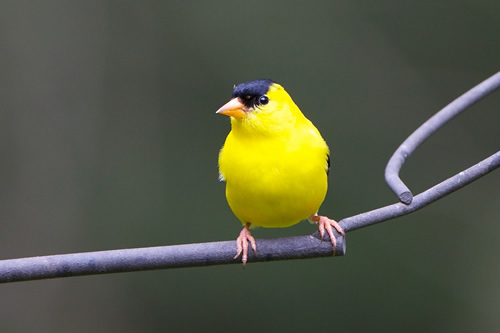
Observer: Paul Lauenstein
Observation Date: 5/19/19
Observation Time: 6:55 a.m.
Observation Location: Moose Hill Audubon Wildlife Sanctuary
Common Name: American Goldfinch (male)
Scientific Name: Carduelis tristis
Comments: This common finch travels in groups. Its song sounds like “per-chick-o-ree, per-chick-o-ree” interspersed with an occasional mewing sound.
More Information: All About Birds
Observer: Paul Lauenstein
Observation Date: 5/11/23
Observation Time: 8:00 a.m.
Observation Location: Moose Hill Audubon Wildlife Sanctuary
Common Name: American redstart
Scientific Name: Setophaga ruticilla
Comments: Redstarts are members of the warbler family. Their song is variable, and can be confused with the songs of some other warblers. See: http://www.allaboutbirds.org/
More Information: All About Birds
Observer: Paul Lauenstein
Observation Date: 5/16/15
Observation Time: 8:30 a.m.
Observation Location: Moose Hill Audubon Wildlife Sanctuary
Common Name: American redstart
Scientific Name: Setophaga ruticilla
Comments: Redstarts are members of the warbler family. Their song is variable, and can be confused with the songs of some other warblers. See: http://www.allaboutbirds.org/
More Information: All About Birds
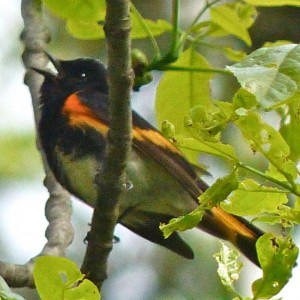
Observer: Paul Lauenstein
Observation Date: 5/17/20
Observation Time: 9:00 a.m.
Observation Location: wooded trail near Gavins Pond
Common Name: American redstart
Scientific Name: Setophaga ruticilla
Comments: Redstarts are members of the warbler family. Their song is variable, and can be confused with the songs of some other warblers. See: http://www.allaboutbirds.org/
More Information: All About Birds
Observer: Josh Simons
Observation Date: 5/31/20
Observation Time: 2:15 p.m.
Observation Location: Moose Hill area
Common Name: American Robin
Scientific Name: Turdus migratorius
Comments: Robins eat different types of food depending on the time of day: more earthworms in the morning and more fruit later in the day. Because the robin forages largely on lawns, it is vulnerable to pesticide poisoning and can be an important indicator of chemical pollution.
Although robins are considered harbingers of spring, many American Robins spend the whole winter in their breeding range. But because they spend more time roosting in trees and less time in your yard, you’re much less likely to see them. The number of robins present in the northern parts of the range varies each year with the local conditions.
Robins eat a lot of fruit in fall and winter. When they eat honeysuckle berries exclusively, they sometimes become intoxicated.
More Information: All About Birds
Observer: Paul Lauenstein
Observation Date: 6/2/10
Observation Time: 6:05 p.m.
Observation Location: 4 Gavins Pond Road
Common Name: American Robin (eggs)
Scientific Name: Turdus migratorius
More Information: All About Birds
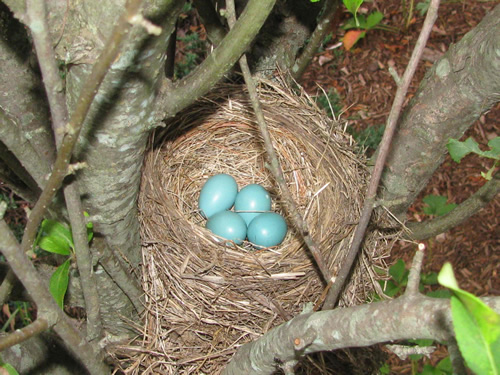
Observer: James Berkland
Observation Date: 6/20/14
Observation Location: 161 Upland Street
Common Name: American Robin (leucistic)
Scientific Name: Turdus migratorius
More Information: All About Birds: Color Variations
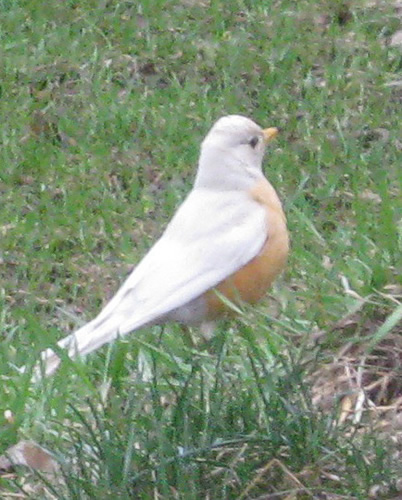
Observer: Vin Zollo
Observation Date: 5/30/13
Observation Time: 10:45 a.m.
Observation Location: Lake Massapoag
Common Name: American White Pelican
Scientific Name: Pelecanus erythrorhynchos
Comments: Originally spotted by Valerie White while canoeing on the lake. This is a rare bird in Massachusetts and a possible first record for Norfolk County. It was there for about a day and a half. Phone-scoped picture.
Another photo can be found on Flickr.
More Information: All About Birds

Observer: Paul Lauenstein
Observation Date: 3/11/10
Observation Time: 5:45 p.m.
Observation Location: Gavins Pond Road across the street from the soccer fields
Common Name: American Woodcock
Scientific Name: Scolopax minor
Comments: The “peents” began at 5:45. The spectacular mating flights began about 6:00 p.m. They will continue every evening at dusk (getting later as the days grow longer) for another month or so. Call me at 781-784-2986 for more particulars on when and where to observe the woodcock mating flight.
Youtube video of woodcock mating flight: https://www.youtube.com/watch?v=ta1fxy0MR2c&t=6s
Youtube video of woodcocks “waltzing”: https://www.youtube.com/watch?v=eSh9Shgwc5o
More Information: All About Birds
Observer: Richard Mandell
Observation Date: 3/9/20
Observation Time: afternoon
Observation Location: 580 Mountain St.
Common Name: American Woodcock
Scientific Name: Scolopax minor
Comments: Woodcocks are also called timberdoodles. They nest on the ground, and are very well camouflaged.
Youtube video of woodcock mating flight: https://www.youtube.com/watch?v=ta1fxy0MR2c&t=6s
Youtube video of woodcocks “waltzing”: https://www.youtube.com/watch?v=eSh9Shgwc5o
More Information: All About Birds
Observer: Richard Mandell
Observation Date: 5/24/19
Observation Time: afternoon
Observation Location: 580 Mountain St.
Common Name: American Woodcock
Scientific Name: Scolopax minor
Comments: Woodcocks are also called timberdoodles. They nest on the ground, and are very well camouflaged.
Youtube video of woodcock mating flight: https://www.youtube.com/watch?v=ta1fxy0MR2c&t=6s
Youtube video of woodcocks “waltzing”: https://www.youtube.com/watch?v=eSh9Shgwc5o
More Information: All About Birds
Observer: Jeff Tatro
Observation Date: 1/19/09
Observation Time: 4:00 p.m.
Observation Location: Lake Massapoag shore, 100 yd SSE of Yacht Club Beach
Common Name: Bald Eagle
Scientific Name: Haliaeetus leucocephalus
Comments: Adult, big guy, plumage very clear. Perched 35 ft up in a tree, then took light toward Community Ctr. Positive ID!
More Information: Boidnoise: Adult Bald Eagle Call
Observer: Deborah Radovsky
Observation Date: 1/4/23
Observation Time: 3:15
Observation Location: Massapoag Ave, near Massapoag Lane, in a tree on edge of lake
Common Name: Bald Eagle
Scientific Name: Haliaeetus leucocephalus
Comments: This is a juvenile, between 3-4 years of age. Bald eagles can live a long time. The oldest recorded bird in the wild was at least 38 years old when it was hit and killed by a car in New York in 2015. It had been banded in the same state in 1977.
The largest bald eagle nest on record, in St. Petersburg, Florida, was 2.9 meters in diameter and 6.1 meters tall. Another famous nest—in Vermilion, Ohio—was shaped like a wine glass and weighed almost two metric tons. It was used for 34 years until the tree blew down.
More Information: All About Birds
Observer: Faith Berkland
Observation Date: 10/29/18
Observation Time: 8:00 AM
Observation Location: 302 Mansfield Street
Common Name: Bald Eagle
Scientific Name: Haliaeetus leucocephalus
Comments:
More Information: http://www.baldeagleinfo.com/
Observer: Todd Arnold
Observation Date: 11/30/18
Observation Time: 10:45 a.m.
Observation Location: Lake Massapoag
Common Name: Bald Eagle
Scientific Name: Haliaeetus leucocephalus
Comments: Large bird with white head and tail feathers spotted over Lake Massapoag. Unquestionably a bald eagle, it was seen riding the thermals before the clouds rolled in and covered the sun. Could this one be scouting a good spot to nest? Or was it just looking for something in the lake to eat?
More Information: https://en.wikipedia.org/wiki/Bald_eagle
Observer: Alison Siegel
Observation Date: 12/20/09
Observation Time: noon
Observation Location: Lakeview St.
Common Name: Bald Eagle
Scientific Name: Haliaeetus leucocephalus
Comments: While drinking hot chocolate after a morning of sledding, four of us clearly saw a bald eagle fly over our backyard. It was flying from Lake Massapoag toward the woods.
More Information: All About Birds: Bald Eagle
Observer: Bonnie Tate
Observation Date: 12/30/13
Observation Time: 3:00 p.m.
Observation Location: Massapoag
Common Name: Bald Eagle
Scientific Name: Haliaeetus leucocephalus
Comments: Eating carrion on the lake just beyond Pond St. on Massapoag Ave.
More Information: Boidnoise: Adult Bald Eagle Call
Observer: Ken Weiner
Observation Date: 2/19/10
Observation Time: 2:00 p.m.
Observation Location: Chessman Drive, Sharon
Common Name: Bald Eagle
Scientific Name: Haliaeetus leucocephalus
Comments: Definite ID from about 200 ft away. Eagle was flying. Possibly a second eagle further away. Did not get picture.
More Information: All About Birds: Bald Eagle
Observer: Ilan Fisher
Observation Date: 2/24/09
Observation Time: 3:00 p.m.
Observation Location: Lake Massapoag
Common Name: Bald Eagle
Scientific Name: Haliaeetus leucocephalus
More Information: All About Birds: Bald Eagle
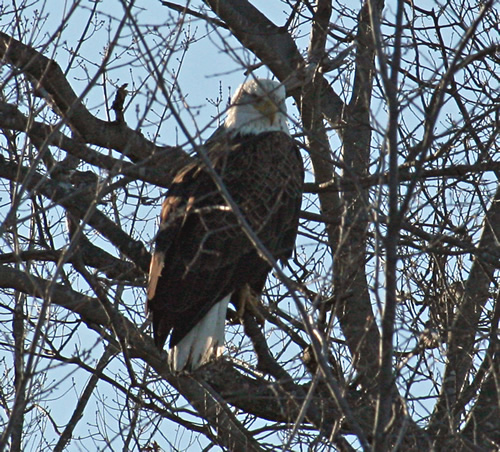
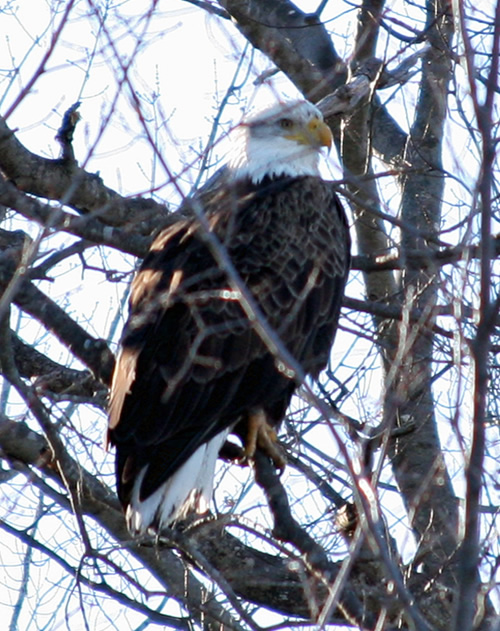
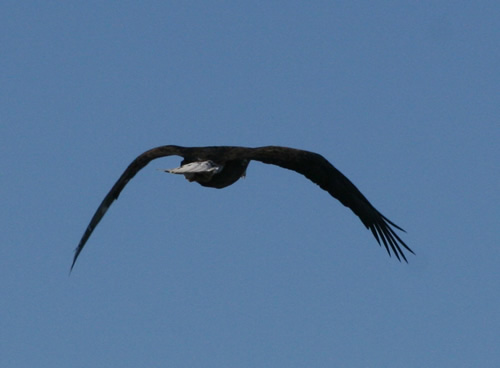
Observer: Carol Moawed
Observation Date: 3/20/13
Observation Time: 11:15 a.m.
Observation Location: Massapoag, near entrance to community
center
Common Name: Bald Eagle
Scientific Name: Haliaeetus leucocephalus
Comments: He was flying down near the edge of lake, it looked like he was going after something on the edge of the lake. I was shocked and thrilled to see him.
More Information: Boidnoise: Adult Bald Eagle Call
Observer: Paul Lauenstein
Observation Date: 4/2/11
Observation Time: 4:15 p.m.
Observation Location: Gavins Pond soccer field parking lot
Common Name: Bald Eagle
Scientific Name: Haliaeetus leucocephalus
Comments: Adult with white head and tail. Very distinctive!
More Information: Boidnoise: Adult Bald Eagle Call
Observer: Deborah Radovsky
Observation Date: 6/14/22
Observation Time: morning
Observation Location: In tree along edge of lake, Massapoag Ave near Potter Avenue
Common Name: Bald Eagle
Scientific Name: Haliaeetus leucocephalus
Comments: Bald eagles can live a long time. The oldest recorded bird in the wild was at least 38 years old when it was hit and killed by a car in New York in 2015. It had been banded in the same state in 1977.
The largest bald eagle nest on record, in St. Petersburg, Florida, was 2.9 meters in diameter and 6.1 meters tall. Another famous nest—in Vermilion, Ohio—was shaped like a wine glass and weighed almost two metric tons. It was used for 34 years until the tree blew down.
More Information: All About Birds
Observer: Richard Kramer
Observation Date: 6/4/19
Observation Time: noon
Observation Location: Lake Massapoag
Common Name: Bald Eagle
Scientific Name: Haliaeetus leucocephalus
Comments: Bald eagles can live a long time. The oldest recorded bird in the wild was at least 38 years old when it was hit and killed by a car in New York in 2015. It had been banded in the same state in 1977.
The largest bald eagle nest on record, in St. Petersburg, Florida, was 2.9 meters in diameter and 6.1 meters tall. Another famous nest—in Vermilion, Ohio—was shaped like a wine glass and weighed almost two metric tons. It was used for 34 years until the tree blew down.
More Information: All About Birds
Observer: Ilan Fisher
Observation Date: 2/18/09
Observation Time: Early afternoon
Observation Location: Lake Massapoag across from Arboro Drive
Common Name: Bald Eagle & Deer
Scientific Name: Haliaeetus leucocephalus
Comments: A young bald eagle feeds on a deer carcass on the ice.
More Information: All About Birds: Bald Eagle
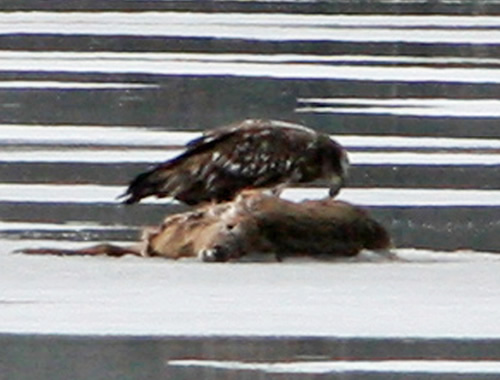
Observer: Josh Simons
Observation Date: 11/21/12
Observation Time: 9:00 a.m.
Observation Location: Moose Hill area
Common Name: Baltimore Oriole
Scientific Name: Icterus galbula
Comments: I’m told this is an immature male oriole. Unusual to see in November.
More Information: All About Birds
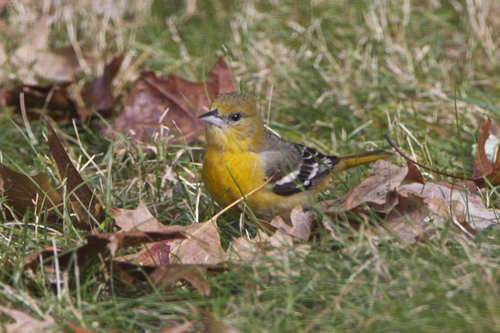
Observer: Paul Lauenstein
Observation Date: 5/10/12
Observation Time: 7:00 p.m.
Observation Location: Gavins Pond Dam
Common Name: Baltimore Oriole
Scientific Name: Icterus galbula
Comments: First I heard the flutelike call, and then I spotted the brilliant orange oriole in an oak tree just pushing out its first leaves of spring. Even though it was 7:00 p.m. and the sun was low, the bird fairly glowed. I wonder how such a gaudy creature manages to escape the notice of hawks.
Orioles weave hanging nests, and feed on fruit, nectar and insects. They have a counterpart in the tropics called a troupial, which is slightly larger, but sings an uncannily similar song.
More Information: All About Birds
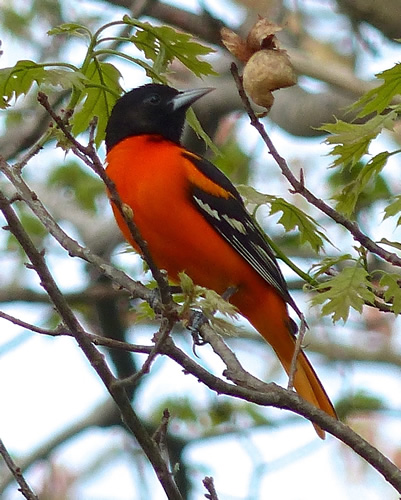
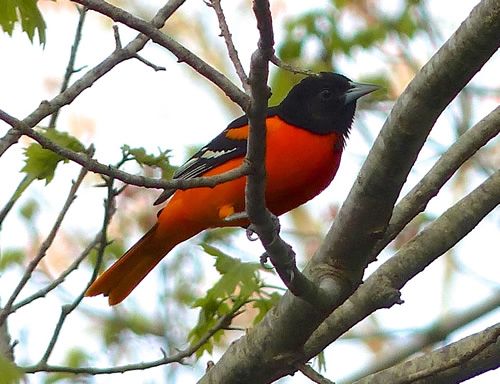
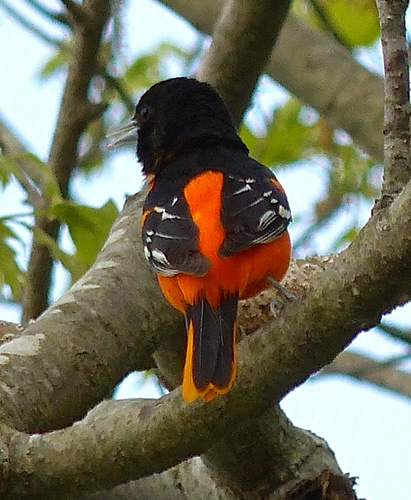
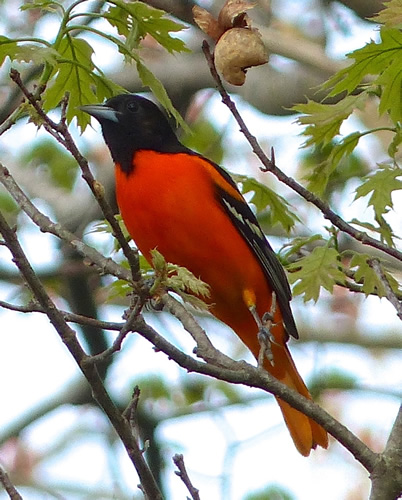
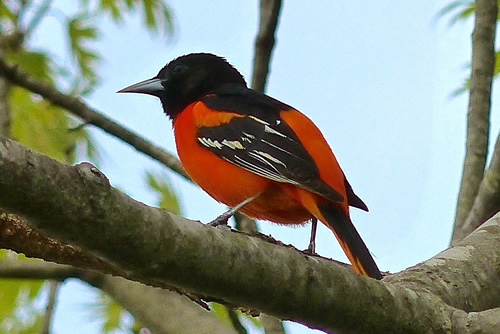
Observer: Josh Simons
Observation Date: 5/12/20
Observation Time: 3:00 p.m.
Observation Location: Moose Hill area
Common Name: Baltimore Oriole
Scientific Name: Icterus galbula
Comments: The oriole’s flutelike call is quite distinctive, once you know what to listen for.
More Information: All About Birds
Observer: Paul Lauenstein
Observation Date: 5/12/23
Observation Time: 6:05 a.m.
Observation Location: Moose Hill Audubon WIldlife Sanctuary (Billings Loop near the barn)
Common Name: Baltimore Oriole
Scientific Name: Icterus galbula
Comments: A pair of orioles has woven a hanging nest in one of the two huge sugar maple trees near the Billings Loop barn. Those two sugar
More Information: All About Birds
Observer: Josh Simons
Observation Date: 5/13/23
Observation Time: 4:00 p.m.
Observation Location: Moose Hill Parkway
Common Name: Baltimore Oriole
Scientific Name: Icterus galbula
Comments: Baltimore Orioles seek out ripe fruit. Cut oranges in half and hang them from trees to invite orioles into your yard. Special oriole feeders filled with sugar water supplement the flower nectar that Baltimore Orioles gather. You can even put out small amounts of jelly to attract these nectar-eaters (just don’t put out so much that it risks soiling their feathers). Planting bright fruits and nectar-bearing flowers, such as raspberries, crab apples, and trumpet vines, can attract Baltimore Orioles year after year. Find out more about what this bird likes to eat and what feeder is best by using the Project FeederWatch Common Feeder Birds bird list.
More Information: All About Birds
Observer: Paul Lauenstein
Observation Date: 5/14/14
Observation Time: 2:20 p.m.
Observation Location: Moose Hill Audubon Wildlife Sanctuary
Common Name: Baltimore Oriole
Scientific Name: Icterus galbula
Comments: Orioles weave a unique hanging nest.
More Information: All About Birds
Observer: Paul Lauenstein
Observation Date: 5/14/15
Observation Time: 6:45
Observation Location: Moose Hill Audubon Wildlife Sanctuary
Common Name: Baltimore Oriole
Scientific Name: Icterus galbula
Comments: Baltimore orioles are among the most brightly colored birds found in Sharon. They weave remarkable hanging nests.
More Information: All About Birds
Observer: Paul Lauenstein
Observation Date: 5/26/19
Observation Time: 3:40 p.m.
Observation Location: Moose Hill Farm (formerly the Kendall Estate)
Common Name: Baltimore Oriole
Scientific Name: Icterus galbula
Comments: I heard this oriole’s flutelike call before I spotted it.
More Information: All About Birds
Observer: Paul Lauenstein
Observation Date: 5/6/15
Observation Time: 2:30 p.m.
Observation Location: tree near Gavins Pond
Common Name: Baltimore Oriole
Scientific Name: Icterus galbula
Comments: I heard this oriole’s flutelike call before I spotted it. You can listen to a recording of an oriole’s song at: http://www.allaboutbirds.org/guide/Baltimore_Oriole/sounds
Observer: Paul Lauenstein
Observation Date: 5/8/23
Observation Time: 8:45 a.m.
Observation Location: Moose Hill Audubon WIldlife Sanctuary
Common Name: Baltimore Oriole
Scientific Name: Icterus galbula
Comments: The oriole’s flutelike call is quite distinctive, once you know what to listen for. I heard this oriole before I saw it.
More Information: All About Birds
Observer: Punitha Hanumantha
Observation Date: 5/25/23
Observation Time: 5:00 p.m.
Observation Location: Fales Rd., Sharon
Common Name: Baltimore Oriole (female or immature male)
Scientific Name: Icterus galbula
Comments: Baltimore Orioles seek out ripe fruit. Cut oranges in half and hang them from trees to invite orioles into your yard. Special oriole feeders filled with sugar water supplement the flower nectar that Baltimore Orioles gather. You can even put out small amounts of jelly to attract these nectar-eaters (just don’t put out so much that it risks soiling their feathers). Planting bright fruits and nectar-bearing flowers, such as raspberries, crab apples, and trumpet vines, can attract Baltimore Orioles year after year. Find out more about what this bird likes to eat and what feeder is best by using the Project FeederWatch Common Feeder Birds bird list.
More information: All About Birds
Observer: Paul Lauenstein
Observation Date: 5/13/19
Observation Time: 7:00 a.m.
Observation Location: Moose Hill Audubon Wildlife Sanctuary
Common Name: Baltimore Oriole (female)
Scientific Name: Icterus galbula
Comments: Baltimore oriole females are much drabber than the bright-orange males. This acrobatic individual seemed to be eating the petals of this flowering crabapple tree.
More Information: All About Birds
Observer: Paul Lauenstein
Observation Date: 5/16/20
Observation Time: 7:35 a.m.
Observation Location: parking area at Gavins Pond soccer fields
Common Name: Baltimore Oriole (female)
Scientific Name: Icterus galbula
Comments: I spotted this female oriole as I was about to get into the car and leave. Nature finds you if you spend time outside, especially in a town like Sharon with plenty of natural open spaces and trails.
The oriole’s flutelike call is quite distinctive, once you know what to listen for.
More Information: All About Birds
Observer: Paul Lauenstein
Observation Date: 5/9/23
Observation Time: 6:50 a.m.
Observation Location: Moose Hill Audubon WIldlife Sanctuary
Common Name: Baltimore Oriole
Scientific Name: Icterus galbula
Comments: This oriole was building its hanging nest in one of the huge sugar maple trees near the barn on the Billings Loop.
More Information: All About Birds
This last photo was taken on 5/11/23. The nest is almost complete in just two days!
Observer: Paul Lauenstein
Observation Date: 5/12/16
Observation Time: 7:50 a.m.
Observation Location: Moose Hill Audubon Wildlife Sanctuary
Common Name: Baltimore Oriole
Scientific Name: Icterus galbula
Comments: Baltimore orioles are among the most brightly colored birds found in Sharon. They weave remarkable hanging nests.
More Information: All About Birds
Observer: Paul Lauenstein
Observation Date: 5/19/20
Observation Time: 11:10 a.m.
Observation Location: under the high tension lines across the street from the Gavins Pond soccer fields
Common Name: Baltimore Oriole
Scientific Name: Icterus galbula
Comments: The oriole’s flutelike call is quite distinctive, once you know what to listen for.
More Information: All About Birds
Observer: Paul Lauenstein
Observation Date: 5/29/14
Observation Time: 12:35 p.m.
Observation Location: stone hut by Upper Leach Pond at Borderland State Park
Common Name: Barn Swallow
Scientific Name: Hirundo rustica
Comments: Barn swallows are passerine birds, which includes more than half of all bird species. A passerine bird has three toes pointing forward and one back. This facilitates perching. The passerines form one of the most diverse terrestrial vertebrate orders, with over 5,000 identified species.
More Information: All About Birds
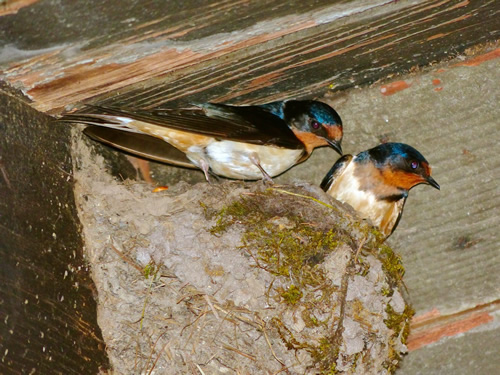
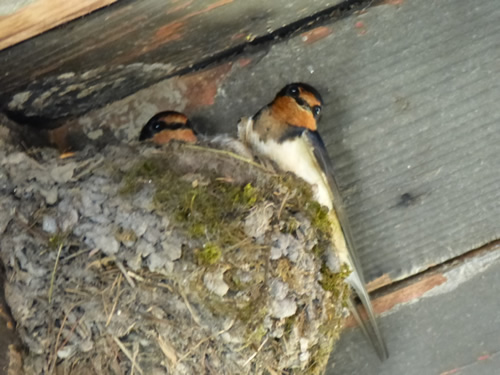
Observer: Randi Simons
Observation Date: 11/14/08
Observation Time: Mid-afternoon
Observation Location: Moose Hill Parkway, Mass. Audubon conservation land
Common Name: Barred Owl
Scientific Name: Strix varia
Comments: This owl sat on a branch close to the road for an hour or more, not bothered by people watching close by or by chickadees constantly scolding.
More Information: Cornell Lab of Ornithology “All About Birds”
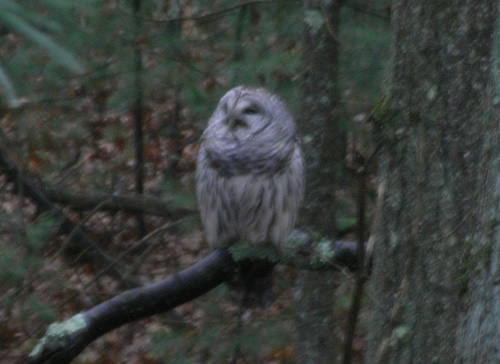
Observer: Paul Lauenstein
Observation Date: 5/15/20
Observation Time: 7:45 a.m.
Observation Location: conservation land near Lakeview & Morse
Common Name: Barred Owl
Scientific Name: Strix varia
Comments: A common owl in Sharon, the barred owl’s vocalization sounds like, “Who cooks for you? Who cooks for you all?”
Barred Owls don’t migrate, and they don’t even move around very much. Of 158 birds that were banded and then found later, none had moved farther than 6 miles away.
More Information: All About Birds
Observer: Marshall Katler
Observation Date: 5/24/22
Observation Time: 9:00 a.m.
Observation Location: King Phillip Trail near King Phillip Rd.
Common Name: Barred Owl
Scientific Name: Strix varia
Comments: At least 2 barred owls were calling, possibly 3. They were identified by the call since they were quite far from the trail.
More Information: All About Birds
Observer: Dan O’Brien
Observation Date: 5/3/24
Observation Time: 7:45 a.m.
Observation Location: Moose Hill Audubon Wildlife Sanctuary
Common Name: Barred Owl
Scientific Name: Strix varia
Comments: This barred owl perched high in a tree near the trail. A short while after this photo was taken, the owl was heard making its familiar “Who cooks for you, who cooks for you all?” call.
More Information: All About Birds
Observer: Nancy Mollitor
Observation Date: 5/8/16
Observation Time: morning
Observation Location: Moose Hill Audubon Wildlife Sanctuary
Common Name: Barred Owl (juvenile)
Scientific Name: Strix varia
Comments: A common owl in Sharon, the barred owl’s vocalization sounds like, “Who cooks for you? Who cooks for you all?”
Barred Owls don’t migrate, and they don’t even move around very much. Of 158 birds that were banded and then found later, none had moved farther than 6 miles away.
More Information: All About Birds
Observer: Bruce Lewis
Observation Date: 7/6/24
Observation Time: 5:00 p.m.
Observation Location: Top of the bend on Moose Hill Street
Common Name: Barred Owl
Scientific Name: Strix varia
Comments: This is the first owl I’ve seen in three years.
More Information: All About Birds
Observer: Paul Lauenstein
Observation Date: 5/23/23
Observation Time: 6:20 a.m.
Observation Location: Moose Hill Audubon Wildlife Sanctuary
Common Name: Bay-breasted Warbler
Scientific Name: Setophaga castanea
Comments: Bay-breasted warblers migrate through Sharon in May en route to their summertime breeding areas in Canada. They eat insects and spiders to keep up their energy during the long flight.
Even for experienced bird watchers, bay-breasted warblers are an unusual find. They are typically seen high up in tall trees, making good photos of them especially challenging. Populations of bay-breasted warbler appear to be decreasing throughout their range. The U.S. has seen a decline of almost 3% per year between 1966 and 2014, resulting in a cumulative decline of 74%, according to the North American Breeding Bird Survey.
More Information: All About Birds and American Bird Conservancy
Observer: Paul Lauenstein
Observation Date: 5/24/18
Observation Time: 6:30 a.m.
Observation Location: Moose Hill Audubon Wildlife Sanctuary
Common Name: Bay-breasted Warbler
Scientific Name: Setophaga castanea
Comments: Bay-breasted warblers migrate through Sharon in May en route to their summertime breeding areas in Canada. They eat insects and spiders to keep up their energy during the long flight.
Even for experienced bird watchers, bay-breasted warblers are an unusual find. They are typically seen high up in tall trees, making good photos of them especially challenging. Populations of bay-breasted warbler appear to be decreasing throughout their range. The U.S. has seen a decline of almost 3% per year between 1966 and 2014, resulting in a cumulative decline of 74%, according to the North American Breeding Bird Survey.
More Information: All About Birds and American Bird Conservancy
Observer: Deborah Radovsky
Observation Date: 11/24/18
Observation Time: 8:30 a.m.
Observation Location: in a tree at the edge of Lake Massapoag, near Beach St.
Common Name: Belted Kingfisher
Scientific Name: Megaceryle alcyon
Comments: Kingfishers have also been sighted near the boat launch area and in the Gavins Pond area. They dive for small fish. They nest in burrows.
More Information: All About Birds
Observer: Paul Lauenstein
Observation Date: 8/3/10
Observation Time: 9:30 a.m.
Observation Location: Gavins Pond
Common Name: Belted Kingfisher
Scientific Name: Megaceryle alcyon
Comments: A pair of belted kingfishers were diving simultaneously several times into Gavins Pond. The bottom photo shows the splash of the kingfisher diving in.
Kingfishers nest in burrows on the banks of ponds and rivers.
More Information: University of Massachusetts

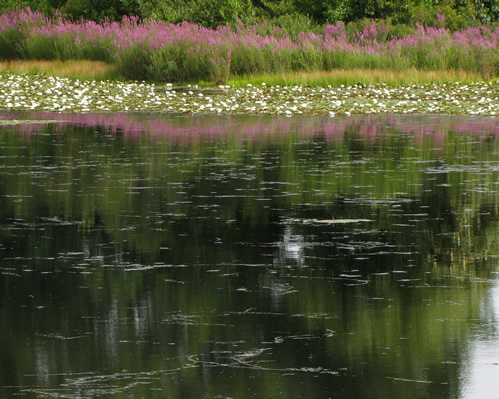
Observer: Paul Lauenstein
Observation Date: 9/18/14
Observation Time: 2:50 p.m.
Observation Place: near Lake Massapoag boat launching ramp
Common Name: Belted Kingfisher
Scientific Name: Megaceryle alcyon
Comments: Belted kingfishers nest in a burrow, usually in a dirt bank near water. Their call is a distinctive, scolding chatter. Check out the recordings at the link below.
More Information: All About Birds
Observer: Lauren Kilmer
Observation Date: 9/23/24
Observation Time: 2:03 p.m.
Observation Location: Borderland State Park (Morse Loop Cedar Swamp)
Common Name: Belted Kingfisher
Scientific Name: Megaceryle alcyon
Comments: First heard the bird calls, confirmed it with Merlin Bird app, then saw two kingfishers flying low on the southeast portion of the swamp.
More Information: All About Birds
Observer: Paul Lauenstein
Observation Date: 9/9/13
Observation Time: 2:05 p.m.
Observation Location: Gavins Pond Dam
Common Name: Belted Kingfisher
Scientific Name: Megaceryle alcyon
Comments: These charismatic birds dive for fish. Believe it or not, they nest in burrows on the banks of streams and ponds.
More Information: University of Massachusetts
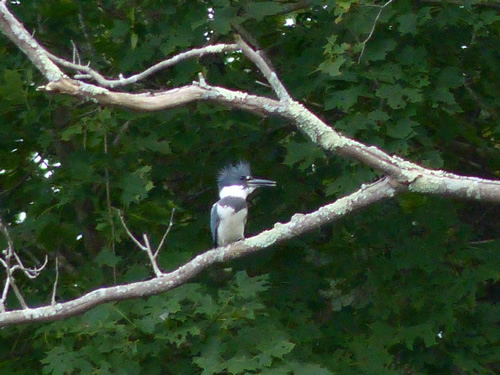
Observer: Paul Lauenstein
Observation Date: 5/11/19
Observation Time: 10:30 a.m.
Observation Location: Moose Hill Audubon Wildlife Sanctuary
Common Name: Black-and-white Warbler
Scientific Name: Mniotilta varia
Comments: Black and white warblers make a high-pitched squeaking sound like a turning wheel that needs to be oiled. They are most often found scurrying up and down tree trunks and branches looking under the bark for insect larvae. The one in the photo has caught its breakfast.
More Information: All About Birds
Observer: Paul Lauenstein
Observation Date: 5/13/14
Observation Time: 7:35 a.m.
Observation Location: Moose Hill Audubon Wildlife Sanctuary
Common Name: Black and White Warbler
Scientific Name: Mniotilta varia
Comments: Black and white warblers are usually seen moving up and down tree trunks looking for bugs under the bark.
More Information: All About Birds
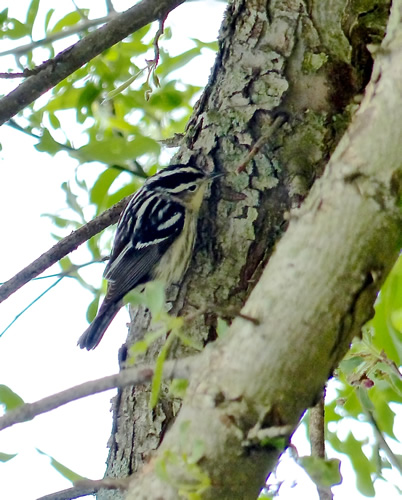
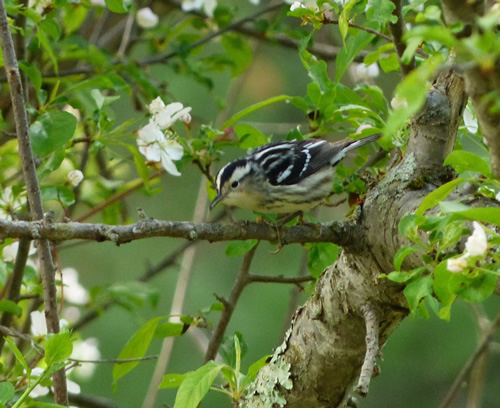
Observer: Paul Lauenstein
Observation Date: 5/3/18
Observation Time: 8:40 a.m.
Observation Location: Moose Hill Audubon Wildlife Sanctuary
Common Name: Black and White Warbler
Scientific Name: Mniotilta varia
Comments: Black and white warblers are usually seen moving up and down tree trunks looking for bugs under the bark.
More Information: All About Birds
Observer: Paul Lauenstein
Observation Date: 5/16/13
Observation Time: 7:30 a.m.
Observation Location: Moose Hill Audubon Wildlife Sanctuary
Common Name: Black and White Warbler (female)
Scientific Name: Mniotilta varia
Comments: Black and white warblers creep along tree trunks and branches foraging for insects. Their high-pitched squeaky song sounds like a wheel turning that needs to be oiled.
More Information: https://www.allaboutbirds.org/guide/Black-and-white_Warbler/overview
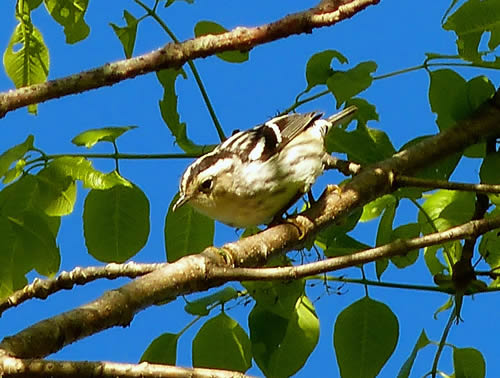
Observer: Josh Simons
Observation Date: 5/13/23
Observation Time: 5:00 p.m.
Observation Location: Moose Hill Parkway
Common Name: Black-and-white warbler
Scientific Name: Mniotilta varia
Comments: Black and white warblers make a high-pitched squeaking sound like a turning wheel that needs to be oiled. They are most often found scurrying up and down tree trunks and branches looking under the bark for insect larvae.
More Information: All About Birds
Observer: Deb Radovsky
Observation Date: 5/18/18
Observation Time: 6:20 p.m.
Observation Location: Moose Hill Audubon Wildlife Sanctuary (boardwalk)
Common Name: Black-and-white Warbler
Scientific Name: Mniotilta varia
Comments: Unlike many other warbler species that migrate through Sharon on their way north, black-and-white warblers stick around all summer. They are typically seen scurrying up and down tree trunks. Their high-pitched song sounds like a squeaky wheel.
More Information: All About Birds
Observer: Paul Lauenstein
Observation Date: 5/3/20
Observation Time: 10:05 a.m.
Observation Location: woods near Gavins Pond
Common Name: Black-and-white warbler
Scientific Name: Mniotilta varia
Comments: Black and white warblers make a high-pitched squeaking sound like a turning wheel that needs to be oiled. They are most often found scurrying up and down tree trunks and branches looking under the bark for insect larvae.
More Information: All About Birds
Observer: Paul Lauenstein
Observation Date: 5/5/20
Observation Time: 7:05 a.m.
Observation Location: Moose Hill Audubon Wildlife Sanctuary
Common Name: Black-and-white warbler
Scientific Name: Mniotilta varia
Comments: Black and white warblers make a high-pitched squeaking sound like a turning wheel that needs to be oiled. They are most often found scurrying up and down tree trunks and branches looking under the bark for insect larvae.
More Information: All About Birds
Observer: Paul Lauenstein
Observation Date: 5/14/15
Observation Time: 7:00 a.m.
Observation Location: Moose Hill Audubon Wildlife Sanctuary
Common Name: Black-billed Cuckoo
Scientific Name: Coccyzus erythropthalmus
Comments: We heard this cuckoo before someone in our group spotted it. They tend to sit quietly on a branch, so the absence of movement makes them hard to find. Black-billed cuckoos have distinctive red eyes.
More Information: All About Birds
Observer: Paul Lauenstein
Observation Date: 5/27/14
Observation Time: 8:05 a.m.
Observation Location: Moose Hill Audubon Wildlife Sanctuary
Common Name: Black-billed Cuckoo
Scientific Name: Coccyzus erythropthalmus
Comments: We heard this black-billed cuckoo before we finally spotted it. Even though cuckoos are relatively large birds, they typically don’t move around much, so they are hard to find unless you know what their call sounds like.
More Information: All About Birds
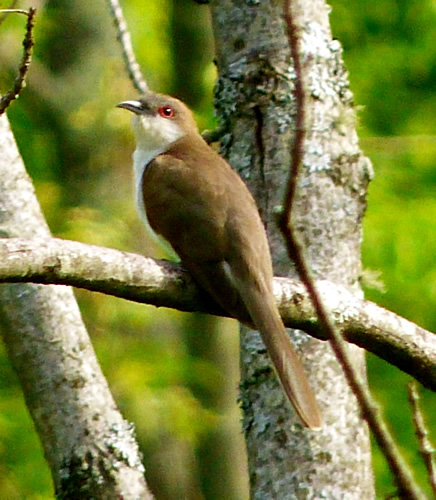
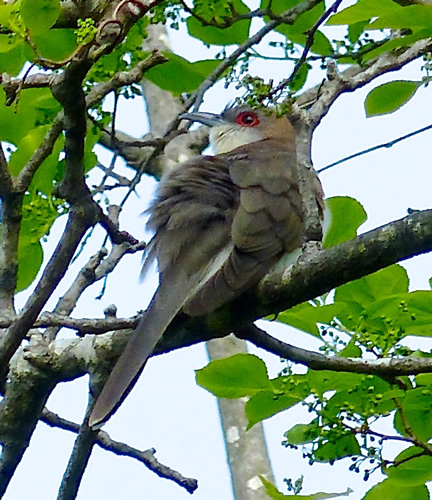
Observer: Paul Lauenstein
Observation Date: 6/14/15
Observation Time: 6:05 p.m.
Observation Location: in the trees between the back soccer field and Gavins Pond
Common Name: Black-billed Cuckoo
Scientific Name: Coccyzus erythropthalmus
Comments: We heard this black-billed cuckoo before we finally spotted it. Even though cuckoos are relatively large birds, they typically don’t move around much, so they are hard to find, unless you know what to listen for.
More Information: All About Birds
Observer: Will Sweet
Observation Date: 2/15/09
Observation Time: 11:00 a.m.
Observation Location: Backyard
Common Name: Black-capped Chickadee
Scientific Name: Poecile atricapillus
Comments: The chickadees were knocking the Pine Siskins off of the thistle feeders.
More Information: Whatbird.com

Observer: Paul Lauenstein
Observation Date: 2/25/20
Observation Time: 12:30 p.m.
Observation Location: Moose Hill Audubon Wildlife Sanctuary
Common Name: Black-capped Chickadee
Scientific Name: Poecile atricapillus
Comments: Chickadees are one of Sharon’s most common birds. They often travel in groups that sometimes include tufted titmouse. With patience, chickadees can be trained to eat sunflower seeds out of your hand!
More Information: All About Birds
Observer: Paul Lauenstein
Observation Date: 4/23/24
Observation Time: 9:00 a.m.
Observation Location: Moose Hill Audubon Wildlife Sanctuary
Common Name: Black-capped Chickadee
Scientific Name: Poecile atricapillus
Comments: Chickadees are one of Sharon’s most common birds. This pair was making a nest in a hollow tree.
More Information: All About Birds
Chickadees often travel in groups that sometimes include tufted titmice. With patience, chickadees can be trained to eat sunflower seeds out of your hand!

